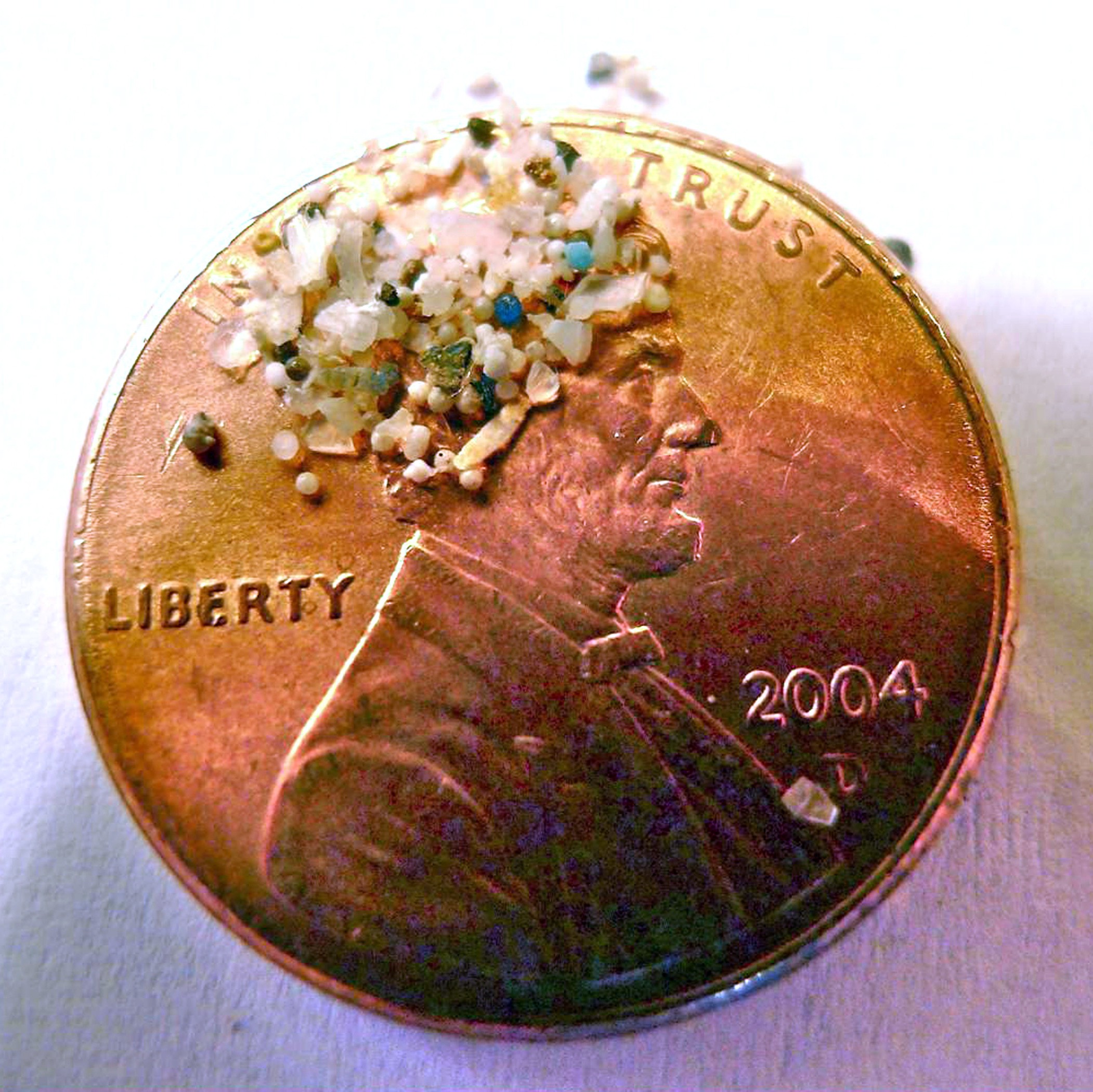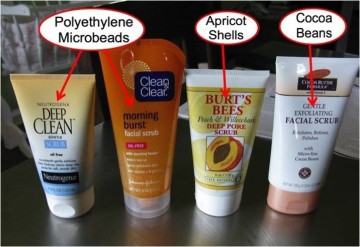
A Tiny Culprit to a Very Large Problem
Monday, May 26, 2014
By Kevin Chlad
 The next opportunity you have, walk to your bathroom and look at your personal care products. Do any of the products you use contain “microbeads?” Chances are, they do. Microbeads are beads of plastic that are 5mm or smaller in diameter that are marketed to customers by offering exfoliating benefits when bathing, washing your face or brushing your teeth. At this time, there are over 100 products sold in the United States that contain microbeads. (The photo to the left shows microbeads on a penny.)
The next opportunity you have, walk to your bathroom and look at your personal care products. Do any of the products you use contain “microbeads?” Chances are, they do. Microbeads are beads of plastic that are 5mm or smaller in diameter that are marketed to customers by offering exfoliating benefits when bathing, washing your face or brushing your teeth. At this time, there are over 100 products sold in the United States that contain microbeads. (The photo to the left shows microbeads on a penny.)
In personal care products, microbeads are typically manufactured using Polyethelyne, a common form of plastic that has quickly become one of the most significant sources of pollution on our globe. Polyethylene is known for its reluctance to biodegrade and ability to absorb persistent organic pollutants (POPs), which also do not biodegrade. Better known examples of POPs include Polychlorinated Biphenyls (PCBs) and Dichlorodiphenyltrichloroethane (DDT).
What happens when you use a product containing microbeads? The beads go down your drain and either into your septic system or a municipal sewer line. If you use a septic system, the beads collect in your tank, inhibiting performance and requiring more frequent visits for emptying, which can get expensive. If you are connected to a municipal wastewater system, the beads make their way from your house into a wastewater treatment plant.
Unfortunately, microbeads are too small to be filtered out of the water in most wastewater treatment plants. Some treatment facilities have advanced screening or filtration capabilities, but during combined sewer overflows, which can happen during times of heavy rain and snowmelt, raw sewage bypasses treatment and enter our waterways unchecked. Out of 610 wastewater treatment plants in New York, only one-third have advanced filtration, which means about 403 are unable to filter out microbeads. While the cost to upgrade all plants lacking this capability would be staggering, it is estimated that 19 tons of microbead plastic enter our waterways each year in New York alone!
The majority of these plastic microbeads float, having a similar appearance to the invertebrates that fish and birds eat. Once microbeads are ingested, any POPs the plastic may have absorbed slowly leach into tissue of the fish and birds, where they bioaccumulates. POPs and other toxins, such as mercury, have led to advisories asking anglers to avoid any consumption of six species of fish in the Adirondacks alone. Birds may also find microbeads as they wash ashore.
Toxins that can be carried by microbeads have been directly linked to reduced shell thicknesses and brood sizes in a number of signature bird species of the Adirondacks. Also as animals spend their time and energy finding and ingesting these pellets, they are not filling their bodies with the calories or nutrients that they need to survive, meaning that microbeads dilute their food supply.
So how can we solve this problem?
 Since our state lacks adequate funding for wastewater treatment improvements and does not encompass homes that use a septic system, the best way quickly becomes clear: we must stop this pollution at the producer. The good news is Proctor and Gamble, Colgate and Johnson and Johnson have all voluntarily agreed to phase out the use of microbeads. These companies have all acknowledged that their products do not require the plastic pellets to be effective since there are already many natural alternatives that can be used that will not increase the price at the cash register.
Since our state lacks adequate funding for wastewater treatment improvements and does not encompass homes that use a septic system, the best way quickly becomes clear: we must stop this pollution at the producer. The good news is Proctor and Gamble, Colgate and Johnson and Johnson have all voluntarily agreed to phase out the use of microbeads. These companies have all acknowledged that their products do not require the plastic pellets to be effective since there are already many natural alternatives that can be used that will not increase the price at the cash register.
And for those who won’t volunteer?
The Adirondack Council is supporting S. 7018 (Grisanti) / S. 8744-A (Sweeney), a bill in the NYS legislature that would ban the sale of any products containing microbeads in New York. The bill is designed to phase out these products from the marketplace by 2016, with a one-year extension for any FDA-approved products. There has been virtually no resistance to the passage of this legislation to-date, indicating that our legislature and the industry understand that our waters are too precious to taint with this pollution that can so easily be prevented.
Do your personal care products contain microbeads?
Products with microbeads
Products that will phase out microbeads
Products that do not contain microbeads
Want more information?
Read NYS Attorney General Eric Scheiderman's Microbead Report
Would you like to comment on what you've read or viewed? We'd love to hear from you.
Please click to send us a message.
Kevin Chlad joined the Adirondack Council staff in 2011 and provides support to the Council’s Albany-based Legislative and Communications team. Kevin assists with outreach to government officials and the media to help spread the word about the Council’s advocacy for the Adirondack Park and specific policies that will impact the Adirondacks.
Kevin Chlad graduated in 2008 with a degree in Environmental Studies of the Adirondacks from SUNY Potsdam. Besides his previous time spent at the Adirondack Council as a Clarence Petty Intern in 2009, Kevin has held numerous other Adirondack occupations, including Ausable River Steward, canoe guide, and fire tower summit steward (Poke-O-Moonshine Mountain). When not advocating ecological integrity, Kevin is an avid ice climber and adventurer.




